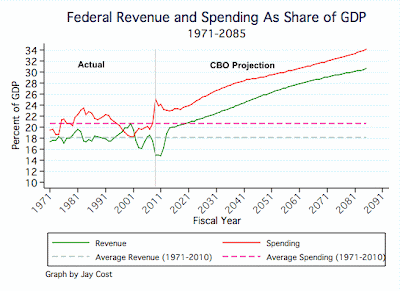Jay Cost, in the Weekly Standard blog, has an interesting chart in his post Morning Jay: Why Won't the GOP Agree to a Tax Increase?. Here it is:
There are several things to observe. The first is that historically over the past 40 years the federal government has collected about 18% of GDP in revenue (green line), and spent a little over 20% (red line), which is why we have the current debt problem.
The second is that the CBO (Congressional Budget Office) projection of what will happen under the current budget projections departs markedly from this long-term average and climbs sharply into "Greek default land" in only a few years. Clearly this is unsustainable.
The administration claims all sorts of terrible things will happen if we cut back spending to what it has been (as a percentage of GDP) over the past 40 years. That seems a bit of a stretch, since the government seemed to do fine at its historic levels of spending (though of course building up a big debt as it did so).
For the long term, clearly the government has to get revenue (green line) and spending (red line) to at least the same percentage of GDP, if it is to stop increasing the federal debt. Preferably it should strive to get some surplus so it can pay down some of the current debt, if for no other reason than to have room for the option of more "stimulus" spending in future recessions (if one is a believer in Keynesian economics).
But the main message of this chart is simply that the administration's current budget plans are simply a fantasy. There is no way we could sustain them. And three years into his presidency, President Obama has yet to propose a plan that gets us out of this mess -- that clearly is the Democratic party's biggest failure to date. Republican have yet to propose a viable plan either, but at least they are striving to cut the spending, and forcing the administration's hand on this.
Thoughts and observations about the world condition.
See also the annotated book list on the sidebar at the right, as well as the YouTube Lecture list
Subscribe To


Blog Archive
-
▼
2011
(205)
-
▼
July
(26)
- Why the Republican Intransigence?
- Recommended: President Obama Is No Longer Tethered...
- Recommended: Can't We Do This Right?
- Recommended: The 4 Percent Universe
- Recommended: The Information
- Recommended: Understanding the World's Greatest St...
- Tax numbers and class warfare
- Recommended: Two Speeches, Two Visions
- Recommended: Congress in the Lead
- My best guess
- Would Democrats really vote for a tax increase?
- The debt negotiations – again!
- Recommended: The Obama Downgrade
- Harry Potter Epitaph
- So where is reality in all of this?
- The debt stalemate - whose to blame?
- Quotation of the week
- Corporate taxes
- How good is a $4 trillion “grand bargain”?
- Interesting graph
- Half the US doesn't pay any taxes
- Recommended: Politics Versus Reality
- An interesting statistic
- Recommended: The Rise and Fall of Al Gore
- Re the last post
- Millionaire's tax breaks - Who's right
-
▼
July
(26)


